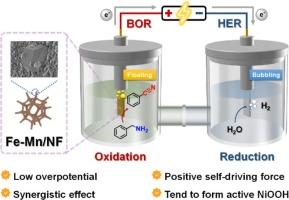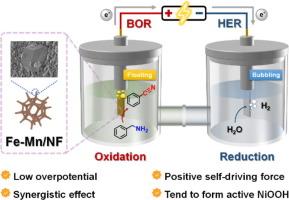低过电位、自适应Fe-Mn共掺杂泡沫镍用于高效电催化胺氧化制腈
IF 6.9
2区 材料科学
Q2 CHEMISTRY, PHYSICAL
引用次数: 0
摘要
从胺中电催化合成高附加值腈提供了一种绿色、可持续和具有成本效益的策略。然而,实现高电催化效率往往需要大量的能源消耗。本文通过简单的一步水热法设计了一种双金属共掺杂Fe-Mn/NF电催化剂,并将其用于苯胺的电催化氧化制备苯腈。与可逆氢电极(RHE)相比,在0.5 M KOH电解液中,电压仅为1.34 V,电流密度可达到10 mA cm−2。高效的电催化活性主要是由于在泡沫镍(NF)材料中掺杂Fe和Mn的协同效应和Jahn-Teller效应,从而促进活性中间体Ni3+ (NiOOH)的形成。同时,原位表征证实了NiOOH在电催化氧化过程中的存在。值得注意的是,作为产物的苯腈和氢可以自动从电催化体系中分离出来,为电催化反应提供了积极的自驱动力。因此,Fe-Mn/NF电催化剂表现出优异的催化性能,合成苯腈的法拉第效率超过98 %。这项工作为开发高催化效率和低能耗的电催化合成腈化合物的电催化剂提供了有价值的见解。本文章由计算机程序翻译,如有差异,请以英文原文为准。


Low-overpotential, self-driving Fe-Mn co-doped nickel foam for highly efficient electrocatalytic oxidation of amines to nitriles
Electrocatalytic synthesis of high value-added nitrile from amines provides a green, sustainable, and cost-effective strategy. However, achieving high electrocatalytic efficiency often requires significant energy consumption. In this work, we designed a bimetallic co-doped Fe-Mn/NF electrocatalyst through a simple one-step hydrothermal process and utilized it for the electrocatalytic oxidation of benzylamine to produce benzonitrile. The current density of 10 mA cm−2 in the 0.5 M KOH electrolyte can be achieved with the voltage of only 1.34 V vs. reversible hydrogen electrode (RHE). The efficient electrocatalytic activity is mainly attributed to the synergistic effect and Jahn–Teller effect of the doped Fe and Mn within the Nickel Foam (NF) materials, thus promoting the formation of the active intermediate Ni3+ (NiOOH). Meanwhile, the in situ characterization confirmed the presence of NiOOH during the electrocatalytic oxidation. Notably, the benzonitrile and hydrogen, as products, can be automatically separated from the electrocatalytic system, providing a positive self-driving force for the electrocatalytic reaction. Thus, the Fe-Mn/NF electrocatalyst exhibits excellent catalytic performance, and the Faraday efficiency for benzonitrile synthesis exceeds 98 %. This work provides valuable insights for developing electrocatalysts that combine high catalytic efficiency with low energy consumption for the electrocatalytic synthesis of nitrile compounds.
求助全文
通过发布文献求助,成功后即可免费获取论文全文。
去求助
来源期刊

Applied Surface Science
工程技术-材料科学:膜
CiteScore
12.50
自引率
7.50%
发文量
3393
审稿时长
67 days
期刊介绍:
Applied Surface Science covers topics contributing to a better understanding of surfaces, interfaces, nanostructures and their applications. The journal is concerned with scientific research on the atomic and molecular level of material properties determined with specific surface analytical techniques and/or computational methods, as well as the processing of such structures.
 求助内容:
求助内容: 应助结果提醒方式:
应助结果提醒方式:


